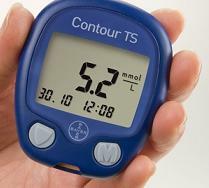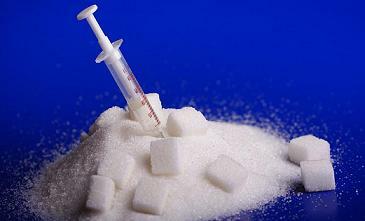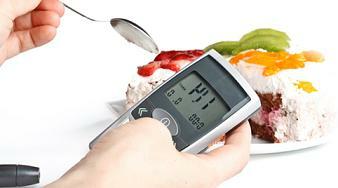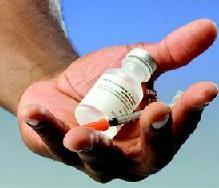 Diabetes mellitus is an endocrine disease caused by a deficiency in the body of the hormone insulin or its low biological activity. It is characterized by a violation of all types of metabolism, damage to large and small blood vessels and manifests itself as hyperglycemia.
Diabetes mellitus is an endocrine disease caused by a deficiency in the body of the hormone insulin or its low biological activity. It is characterized by a violation of all types of metabolism, damage to large and small blood vessels and manifests itself as hyperglycemia.
The first who gave the name of the disease - "diabetes" was the doctor Arethius, who lived in Rome in the second century AD.e. Much later, in 1776, a Dobson doctor( an Englishman by birth), examining the urine of diabetics, discovered that she had a sweetish taste that spoke of the presence of sugar in her. So, diabetes began to be called "sugar".
With any type of diabetes, monitoring blood sugar becomes one of the primary tasks of the patient and his attending physician. The closer the sugar level to the normal limits, the less symptoms of diabetes appear, and the less the risk of complications.
Why does diabetes occur, and what is it?
Diabetes mellitus is a metabolic disorder that occurs due to the lack of education in the body of a patient's own insulin( type 1 disease) or due to a violation of the effect of this insulin on tissues( 2 types).Insulin is produced in the pancreas, and therefore patients with diabetes often find themselves among those who have various abnormalities in the work of this body.
Patients with type 1 diabetes are called "insulin-dependent" - they need regular injections of insulin, and very often they have a congenital disease. Typically, type 1 disease manifests itself in childhood or adolescence, and this type of disease occurs in 10-15% of cases.
Type 2 diabetes develops gradually and is considered "the diabetes of the elderly".This kind of children almost does not occur, and is usually characteristic for people over 40 years old, suffering from excess weight. This type of diabetes occurs in 80-90% of cases, and is inherited in almost 90-95% of cases.
Classification
What is it? Diabetes mellitus can be of two types - insulin-dependent and insulin-independent.
- Type 1 diabetes occurs on a background of insulin deficiency, so it is called insulin-dependent. With this type of disease, the pancreas is functioning inadequately: it either does not produce insulin at all, or produces it in a volume that is insufficient to process even the minimum amount of incoming glucose. As a result, there is an increase in the level of glucose in the blood. As a rule, type 1 diabetes mellitus is caused by thin people under the age of 30.In such cases, patients are given additional doses of insulin to prevent ketoacidosis and maintain a normal standard of living.
- Type 2 diabetes affects up to 85% of all patients with diabetes mellitus, mostly people older than 50 years( especially women).For patients with diabetes of this type, excessive body weight is characteristic: more than 70% of such patients are obese. It is accompanied by the production of a sufficient amount of insulin, to which the tissues gradually lose sensitivity.
The causes of the development of diabetes types I and II are fundamentally different. In type 1 diabetics, due to a viral infection or autoimmune aggression, beta cells producing insulin break down, which is why its deficiency develops with all the dramatic consequences. In patients with type 2 diabetes, beta cells produce enough or even an increased amount of insulin, but tissues lose the ability to perceive its specific signal.

Causes of
Diabetes is one of the most common endocrine disorders with a constant increase in prevalence( especially in developed countries).This is the result of a modern lifestyle and an increase in the number of external etiological factors, among which obesity is recognized.
The main reasons for the development of diabetes are:
- Overeating ( increased appetite), leading to obesity is one of the main factors in the development of type 2 diabetes. If among people with normal body weight the incidence of diabetes is 7.8%, then with an excess of body weight by 20%, the incidence of diabetes is 25%, and with an excess body weight of 50%, the frequency is 60%.
- Autoimmune diseases ( attack of the body's immune system on body tissues) - glomerulonephritis, autoimmune thyroiditis, hepatitis, lupus, etc., can also be complicated by diabetes mellitus.
- Hereditary factor .As a rule, diabetes is several times more common in relatives of patients with diabetes mellitus. If both parents are sick with diabetes mellitus, the risk of diabetes for their children throughout life is 100%, if one of the parents is sick, 50%, in the case of diabetes, the brother or sister - 25%.
- Viral infections of , which destroy pancreatic cells that produce insulin. Among the viral infections that can cause the development of diabetes can be listed: rubella, viral parotitis( mumps), chickenpox, viral hepatitis, and the like.
A person with a genetic predisposition to diabetes can not become a diabetic throughout his life if he controls himself, leading a healthy lifestyle: proper nutrition, physical activity, supervision by a doctor, etc. Typically, the first type of diabetes is manifested in children and adolescents.
As a result of the research, physicians came to the conclusion that the causes of heredity of diabetes mellitus in 5% depend on the mother's line, 10% on the father's line, and in case both parents have diabetes, the probability of transmission of a predisposition to diabetes increases to almost 70%.
Signs of diabetes in women and men
There are a number of signs of diabetes that are typical for both 1 and 2 types of the disease. These include:
- Feeling of unquenchable thirst and frequent urination, which lead to dehydration of the body;
- Also one of the signs is dryness in the mouth;
- Increased fatigue;
- Yawning, drowsiness;
- Weakness;
- Wounds and cuts very slowly heal;
- Nausea, possibly vomiting;
- Respiration is frequent( possibly with acetone odor);
- Rapid heart rate;
- Genital itching and itching of the skin;
- Weight loss;
- Increased urination;
- Visual impairment.
If you have the above signs of diabetes, then you need to measure blood sugar.
Symptoms of diabetes mellitus
 In diabetes, the severity of symptoms depends on the degree of decrease in insulin secretion, the duration of the disease and the individual characteristics of the patient.
In diabetes, the severity of symptoms depends on the degree of decrease in insulin secretion, the duration of the disease and the individual characteristics of the patient.
Typically, symptoms of type 1 diabetes are acute, the disease begins suddenly. In type 2 diabetes, health deteriorates gradually, in the initial stage, the symptoms are meager.
- Excessive thirst and frequent urination are classic signs and symptoms of diabetes. When the disease is excessive sugar( glucose) accumulates in the blood. Your kidneys are forced to work intensively in order to filter and absorb excess sugar. If your kidneys do not cope, excess sugar is excreted from the body in the urine with a liquid from the tissues. This causes more frequent urination, which can lead to dehydration. You will want to drink more liquid to quench your thirst, which again leads to frequent urination.
- Fatigue can be caused by many factors. It can also be caused by dehydration, frequent urination and the inability of the body to function properly, because less sugar can be used to generate energy.
- The third symptom of diabetes is polyphagia. This is also a thirst, however, no longer to water, but to food. The person eats and thus feels not satiety, and filling of a stomach with food which then quickly enough turns to a new hunger.
- Intensive weight loss. This symptom is inherent predominantly type I diabetes( insulin-dependent) and often he is at first happy girls. However, their joy passes when they learn the true cause of weight loss. It is worth noting that weight loss occurs against a background of increased appetite and abundant nutrition, which can not but alarm. Quite often, losing weight leads to exhaustion.
- Symptoms of diabetes can sometimes include problems with eyesight.
- Slow wound healing or frequent infections.
- Tingling in the hands and feet.
- Red, swollen, sensitive gums.
If the first symptoms of diabetes do not take measures, then over time there are complications associated with eating disorders of the tissues - trophic ulcers, vascular disease, changes in sensitivity, decreased vision. A serious complication of diabetes is a diabetic coma that occurs more often with insulin-dependent diabetes in the absence of sufficient insulin treatment.
Degree of severity
A very important rubric in the classification of diabetes is its separation in degrees of severity.
- Characterizes the most favorable course of the disease to which any treatment should strive. At this stage of the process, it is completely compensated, the glucose level does not exceed 6-7 mmol / l, there is no glucosuria( glucose release in the urine), the glycosylated hemoglobin and proteinuria values do not go beyond the normal range.
- This stage of the process indicates partial compensation. There are signs of complications of diabetes and the defeat of typical organs of the targets: eyes, kidneys, heart, vessels, nerves, lower limbs. The level of glucose is elevated slightly and is 7-10 mmol / l.
- A similar course of the process indicates its constant progress and the impossibility of drug control. At the same time, glucose levels range from 13-14 mmol / l, persistent glucosuria( urine glucose release), high proteinuria( presence of protein in the urine), and explicit manifestations of target organ damage in diabetes mellitus. Progressively reduced visual acuity, persists severe arterial hypertension, decreased sensitivity with the appearance of severe pain and numbness of the lower extremities.
- This degree characterizes the absolute decompensation of the process and the development of severe complications. At the same time, the level of glycemia rises to critical figures( 15-25 and more mmol / l), it can not be corrected by any means. The development of renal insufficiency, diabetic ulcers and gangrene of extremities is characteristic. Another criterion for the 4th degree of diabetes is the tendency to develop frequent diabetic comas.
Three states of compensation for violations of carbohydrate metabolism are also distinguished: compensated, subcompensated and decompensated.

Diagnosis
If the following signs coincide, the diagnosis of "diabetes" is established:
- The concentration of glucose in the blood( fasting) exceeded the norm of 6.1 millimoles per liter( mol / l).After eating in two hours - above 11.1 mmol / l;
- If the diagnosis is questionable, a glucose tolerance test is performed in the standard repeat, and it shows an excess of 11.1 mmol / l;
- Exceeding the level of glycosylated hemoglobin - more than 6.5%;
- The presence of sugar in the urine;
- The presence of acetone in the urine, although acetonuria is not always an indicator of diabetes.
What is the norm of sugar?
- 3.3 - 5.5 mmol / l is the norm of blood sugar regardless of your age.
- 5.5 - 6 mmol / l is a prediabetes, a violation of glucose tolerance.
If the sugar level showed a mark of 5.5 - 6 mmol / l is your body's signal that a carbohydrate metabolism violation began, it all means that you entered the danger zone. The first thing you need to do is lower the blood sugar level, get rid of excess weight( if you have extra weight).Limit yourself to consumption of 1800 calories per day, include diabetic foods in your diet, give up sweets, cook for a couple.

Consequences and complications of diabetes
Acute complications are those that develop for days or even hours, with diabetes.
- Diabetic ketoacidosis is a severe condition that develops as a result of the accumulation in the blood of products of intermediate fat metabolism( ketone bodies).
- Hypoglycemia - lowering the blood glucose level below the normal value( usually below 3.3 mmol / l), is due to an overdose of hypoglycemic drugs, concomitant diseases, unusual physical activity or malnutrition, and reception of strong alcohol.
- Hyperosmolar coma .It occurs mainly in elderly patients with type 2 diabetes in or without an anamnesis and is always associated with severe dehydration.
- The lactacidotic coma in patients with diabetes mellitus is caused by accumulation of lactic acid in the blood and more often occurs in patients over 50 years old on the background of cardiovascular, hepatic and renal insufficiency, a lower supply of tissues with oxygen and, as a result, accumulation in tissues of lactic acid.
Late consequences represent a group of complications, the development of which requires months, and in most cases years of the course of the disease.
- Diabetic retinopathy - retinal damage in the form of microaneurysms, spot and spotted hemorrhages, hard exudates, edema, the formation of new vessels. It ends with hemorrhages on the fundus, can lead to detachment of the retina.
- Diabetic micro- and macroangiopathy - impaired vascular permeability, increased fragility, tendency to thrombosis and development of atherosclerosis( occurs early, mostly small vessels are affected).
- Diabetic polyneuropathy - most often in the form of bilateral peripheral neuropathy of the type of "gloves and stockings", starting in the lower parts of the limbs.
- Diabetic nephropathy - renal damage, first in the form of microalbuminuria( excretion of protein albumin in the urine), then proteinuria. It leads to the development of chronic renal failure.
- Diabetic arthropathy - pain in the joints, "crunching", limiting mobility, reducing the amount of synovial fluid and increasing its viscosity.
- Diabetic ophthalmopathy , in addition to retinopathy, includes early development of cataracts( opacity of the lens).
- Diabetic encephalopathy - changes in the psyche and mood, emotional lability or depression.
- Diabetic foot is a lesion of a patient with diabetes mellitus in the form of purulent necrotic processes, ulcers and osteoarticular lesions, which occurs when peripheral nerves, vessels, skin and soft tissues, bones and joints change. It is the main cause of amputation in patients with diabetes mellitus.
Diabetes also increases the risk of developing mental disorders - depression, anxiety disorders and eating disorders.
How to treat diabetes
 Currently, the treatment of diabetes in the vast majority of cases is symptomatic and is aimed at eliminating the existing symptoms without eliminating the cause of the disease, since effective treatment of diabetes has not yet been developed.
Currently, the treatment of diabetes in the vast majority of cases is symptomatic and is aimed at eliminating the existing symptoms without eliminating the cause of the disease, since effective treatment of diabetes has not yet been developed.
The main tasks of the doctor in the treatment of diabetes are:
- Compensation of carbohydrate metabolism.
- Prophylaxis and treatment of complications.
- Normalization of body weight.
- Training of the patient.
Depending on the type of diabetes, patients are prescribed insulin injection or ingestion of drugs that have a sugar reducing effect. Patients should follow a diet whose qualitative and quantitative composition also depends on the type of diabetes mellitus.
- With type 2 diabetes, is prescribed a diet and drugs that reduce blood glucose levels: glibenclamide, glenorhorm, glyclazide, glybutide, metformin. They are taken orally after individual selection of a particular drug and its dosage by a doctor.
- With type 1 diabetes, is prescribed insulin therapy and a diet. The dose and type of insulin( short, medium or long-term action) is selected individually in the hospital, under the control of the sugar content in the blood and urine.
Diabetes mellitus must necessarily be treated, otherwise it is fraught with very serious consequences, which were listed above. The earlier diabetes is diagnosed, the greater the chance that negative consequences can be avoided and live a normal and full life.
Diet
Diabetes is a necessary part of the treatment, as well as the use of hypoglycemic drugs or insulin. Without a diet, compensation for carbohydrate metabolism is impossible. It should be noted that in some cases, with type 2 diabetes, only diets are sufficient to compensate for carbohydrate metabolism, especially in the early stages of the disease. With the 1 st type of diabetes, dieting is vital for the patient, a diet violation can lead to hypo- or hyperglycemic coma, and in some cases to the death of the patient.
The task of dietotherapy for diabetes is to ensure the uniform and adequate physical load of carbohydrate intake into the patient's body. The diet should be balanced by protein, fat and calories. It is necessary to completely exclude digestible carbohydrates from the diet, except for cases of hypoglycemia. In type 2 diabetes, it often becomes necessary to correct body weight.
The basic concept for diet diabetes is a bread unit. Bread unit is a conditional measure equal to 10-12 g of carbohydrates or 20-25 g of bread. There are tables that indicate the number of bread units in different food products. During the day, the number of bread units used by the patient must remain constant;an average of 12-25 bread units per day, depending on body weight and physical activity. For one meal it is not recommended to eat more than 7 bread units, it is desirable to arrange meals so that the number of bread units in different meals is approximately the same. It should also be noted that the use of alcohol can lead to distant hypoglycemia, including hypoglycemic coma.
An important condition for the success of diet therapy is the management of the diary of food, it brings in all the food eaten during the day, and calculates the number of bread units consumed in each meal and in general for a day. The maintenance of such a diary allows in most cases to identify the cause of episodes of hypo- and hyperglycemia, promotes patient education, helps the physician to select an adequate dose of hypoglycemic drugs or insulin.
See more: proper nutrition for diabetes every day. Menu and recipes.
Self-monitoring of
Self-monitoring of the level of glycemia is one of the main measures allowing to achieve effective long-term compensation of carbohydrate metabolism. Due to the fact that it is impossible at the current technological level to fully simulate the secretory activity of the pancreas, fluctuations in blood glucose levels occur during the day. This is influenced by many factors, the main ones are physical and emotional load, level of consumed carbohydrates, concomitant diseases and conditions.
Since it is impossible to keep the patient in the hospital all the time, the monitoring of the condition and the insignificant correction of short-acting insulin doses are imposed on the patient. Self-control of glycemia can be carried out in two ways. The first is approximate with the help of test strips, which determine the level of glucose in the urine using a qualitative reaction, in the presence of glucose in urine, urine should be checked for acetone content. Acetonuria is an indication for inpatient hospitalization and a certificate of ketoacidosis. This method of assessing glycemia is rather approximate and does not allow to fully monitor the state of carbohydrate metabolism.
A more modern and adequate method of assessing the condition is the use of glucometers. Glucometer is a device for measuring glucose level in organic liquids( blood, liquor, etc.).There are several measurement methods. Recently, portable glucometers have been widely used for measurements at home. It is enough to place a drop of blood on a disposable indicator plate attached to the device of a glucose oxidase biosensor, and after a few seconds the level of glucose in the blood( glycemia) is known.
It should be noted that the readings of two glucometers of different firms may differ, and the level of glycemia indicated by the meter is usually 1-2 units higher than the actual one. Therefore, it is desirable to compare the readings of the glucometer with the data obtained during examination in a polyclinic or hospital.
Insulin Therapy
Insulin treatment aims to maximize the possible compensation of carbohydrate metabolism, prevent hypo- and hyperglycemia, and prevent complications of diabetes mellitus. Insulin treatment is vital for people with type 1 diabetes and can be used in a number of situations for people with type 2 diabetes.
Indications for the appointment of insulin therapy:
- Type 1 diabetes
- Ketoacidosis, diabetic hyperosmolar, hyperlacidemic coma.
- Pregnancy and childbirth in diabetes mellitus.
- Significant decompensation of type 2 diabetes mellitus.
- No effect on other types of diabetes mellitus treatment.
- Significant weight loss in diabetes mellitus.
- Diabetic Nephropathy.
At present, there are a large number of insulin preparations that differ in the duration of action( ultrashort, short, medium, extended), in purity( monopic, monocomponent), species specificity( human, porcine, bovine, genetically engineered, etc.).
obesity and strong emotional loads, insulin is prescribed in a dose of 0.5-1 unit per kilogram of body weight per day. The introduction of insulin is designed to simulate physiological secretion in this regard, the following requirements are put forward:
- The dose of insulin should be sufficient for the utilization of glucose entering the body.
- Introduced insulin should mimic the basal secretion of the pancreas.
- Insulin administration should simulate postprandial peaks of insulin secretion.
In this regard, there is a so-called intensified insulin therapy. The daily dose of insulin is divided between long-acting and short-acting insulins. Extended insulins are usually administered in the morning and evening and mimic the basal secretion of the pancreas. Short-acting insulins are administered after each meal containing carbohydrates, the dose may vary depending on the bread units eaten at a given meal.
Insulin is administered subcutaneously, with the help of an insulin syringe, a syringe pen or a special metering pump. At present, in Russia, the most common way of introducing insulin with the help of syringes-pens. This is associated with greater convenience, less pronounced discomfort and ease of administration compared to conventional insulin syringes. Syringe-pen allows you to quickly and practically painlessly enter the necessary dose of insulin.
Sacrificial Anti-Aging Drugs
Sugar-reducing tablet preparations are prescribed for non-insulin-dependent diabetes mellitus in addition to diet. The following groups of hypoglycemic agents are allocated for the mechanism of sugar reduction in blood:
- Biguanides( metformin, buformin, etc.) - reduce the absorption of glucose in the intestine and contribute to the saturation of peripheral tissues. Biguanides can raise the level of uric acid in the blood and cause the development of a severe condition - lactic acidosis in patients over 60 years old, as well as those suffering from hepatic and renal insufficiency, chronic infections. Biguanides are more often prescribed for insulin-dependent diabetes mellitus in young patients with obesity.
- Sulfonylurea preparations( glycvidone, glibenclamide, chlorpropamide, carbutamide) stimulate the production of insulin by β-cells of the pancreas and promote the penetration of glucose into tissues. The optimal dosage of the drugs in this group maintains a glucose level not & gt;8 mmol / l. In case of an overdose it is possible to develop hypoglycemia and coma.
- Inhibitors of alpha-glucosidases( miglitol, acarbose) slow the increase in blood sugar, blocking the enzymes involved in the assimilation of starch. Side effect - flatulence and diarrhea.
- Meglitinides( nateglinide, repaglinide) cause a decrease in the level of sugar, stimulating the pancreas to secrete insulin. The effect of these drugs depends on the sugar content in the blood and does not cause hypoglycemia.
- Thiazolidinediones - reduce the amount of sugar released from the liver, increase the susceptibility of fat cells to insulin. Contraindicated in heart failure.
Also beneficial therapeutic effect in diabetes is the reduction of excess weight and individual moderate physical activity. Due to the muscular effort, the oxidation of glucose increases and its content in the blood decreases.
Forecast
Currently, the prognosis for all types of diabetes is conditionally favorable, with adequately conducted treatment and compliance with the diet remains working capacity. The progression of complications is significantly slowed down or completely stopped. However, it should be noted that in most cases, as a result of treatment, the cause of the disease is not eliminated, and the therapy is only symptomatic.

How to choose probiotics for the intestines: a list of drugs.

Effective and inexpensive cough syrups for children and adults.

Modern non-steroidal anti-inflammatory drugs.

Review of tablets from the increased pressure of the new generation.
 Antiviral drugs are inexpensive and effective.
Antiviral drugs are inexpensive and effective.



